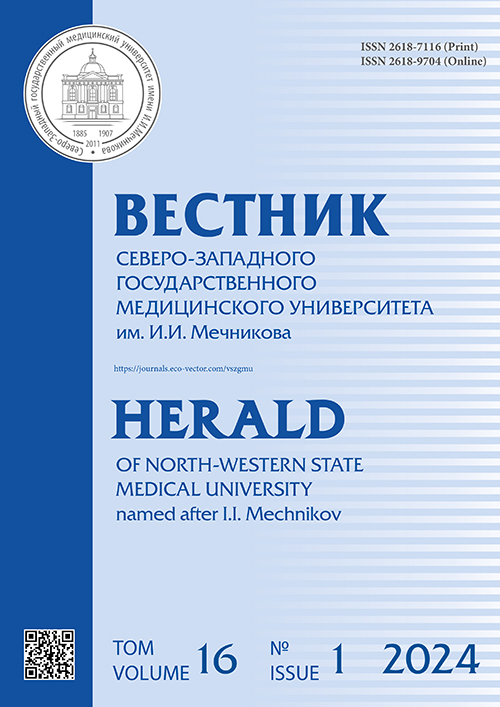Electrocardiographic signs of cardiovascular system dysfunction in the context of various courses of COVID-19 in young and middle-aged individuals
- 作者: Bratilova E.S.1, Kachnov V.A.1, Tyrenko V.V.1
-
隶属关系:
- Kirov Military Medical Academy
- 期: 卷 16, 编号 1 (2024)
- 页面: 41-50
- 栏目: Original study article
- ##submission.dateSubmitted##: 19.01.2024
- ##submission.dateAccepted##: 29.01.2024
- ##submission.datePublished##: 28.03.2024
- URL: https://journals.eco-vector.com/vszgmu/article/view/625789
- DOI: https://doi.org/10.17816/mechnikov625789
- ID: 625789
如何引用文章
详细
BACKGROUD: Intensive monitoring of patients with the coronavirus disease should include functional monitoring of the cardiovascular system. Physiologic methods can detect dysfunction of the cardiovascular system, however, it is not always possible to identify initial or hidden dysfunction. Therefore, clinical data should be complemented with results from instrumental methods, particularly electrocardiography.
AIM: To identify preclinical electrocardiography signs of cardiovascular system dysfunction in the context of various courses of coronavirus disease in young and middle-aged individuals.
MATERIALS AND METHODS: A retrospective analysis of 337 medical records of young and middle-aged individuals (40.0 ± 13.3 years old) was conducted. The analysis of the medical records included electrocardiograms in 12 leads with the assessment of standard parameters, results of laboratory and instrumental tests. In order to identify the main factors predicting an unfavorable course of the coronavirus disease, a factor analysis was conducted using electrocardiography parameters. Logistic regression analysis was used to develop a statistical model for predicting the likelihood of a severe course and fatal outcome of COVID-19, followed by assessing the diagnostic value of the prognostic model using the ROC curve and determining the area under the curve.
RESULTS: The main factors predicting an unfavorable course of the new coronavirus disease in young and middle-aged individuals based on electrocardiography data include the α angle factor, the ventricular repolarization factor and the heart rate factor. In addition, as electrocardiography predictors, the elongation of the P wave and PQ interval, the amplitude of the R wave in lead one, the decrease in the T wave amplitude in the precordial leads, and the amplitude of the R wave in leads two and three can be considered. Based on the identified electrocardiography predictors, a mathematical model for predicting a severe course and fatal outcome of the new coronavirus disease was developed.
CONCLUSIONS: Thus, electrocardiography is an indicative method that can be influenced by infectious process which is performed for all individuals upon admission to the hospital, allowing this examination to be considered the most accessible for detecting preclinical signs of an unfavorable course of COVID-19.
全文:
作者简介
Ekaterina Bratilova
Kirov Military Medical Academy
编辑信件的主要联系方式.
Email: guanilatciclaza@mail.ru
ORCID iD: 0000-0003-2153-2121
SPIN 代码: 4647-2564
cardiologist at the Clinic of faculty therapy
俄罗斯联邦, 6 Akademika Lebedeva St., Saint Petersburg, 194044Vasilii Kachnov
Kirov Military Medical Academy
Email: kvasa@mail.ru
ORCID iD: 0000-0002-6601-5366
SPIN 代码: 2084-0290
MD, Dr. Sci. (Med.) Assistant Professor
俄罗斯联邦, 6 Akademika Lebedeva St., Saint Petersburg, 194044Vadim Tyrenko
Kirov Military Medical Academy
Email: vadim_tyrenko@mail.ru
ORCID iD: 0000-0002-0470-1109
SPIN 代码: 3022-5038
MD, Dr. Sci. (Med.), Professor
俄罗斯联邦, 6 Akademika Lebedeva St., Saint Petersburg, 194044参考
- Parvu S, Müller K, Dahdal D, et al. COVID-19 and cardiovascular manifestations. Eur Rev Med Pharmacol Sci. 2022;26(12):4509–4519. doi: 10.26355/eurrev_202206_29090
- Fauvel C, Trimaille A, Weizman O, et al. Cardiovascular manifestations secondary to COVID-19: A narrative review. Respir Med Res. 2022;81:100904. doi: 10.1016/j.resmer.2022.100904
- Lobzin YV, Semena AV, Finogeev YP, Volzhanin VM, editors. Heart lesions in infectious diseases (clinical and electrocardiographic diagnostics). Guide for Physicians. Saint Petersburg: FOLIANT; 2003. 256 p. (In Russ.) EDN: QLENWX
- Fisun AY, Lobzin YV, Cherkashin DV, et al. Mechanisms of damage to the cardiovascular system in COVID-19. Annals of the Russian Academy of Medical Sciences. 2021;76(3):28–297. (In Russ.). EDN: WUPBRU doi: 10.15690/vramn1474
- Lanza GA, De Vita A, Ravenna SE, et al. Electrocardiographic findings at presentation and clinical outcome in patients with SARS-CoV-2 infection. Europace. 2021;23(1):123–129. doi: 10.1093/europace/euaa245
- McCullough SA, Goyal P, Krishnan U, et al. Electrocardiographic findings in coronavirus disease-19: Insights on mortality and underlying myocardial processes. J Card Fail. 2020;26(7):626–632. doi: 10.1016/j.cardfail.2020.06.005
- van de Leur RR, Bleijendaal H, Taha K, et al. Electrocardiogram-based mortality prediction in patients with COVID-19 using machine learning. Neth Heart J. 2022;30(6):312–318. doi: 10.1007/s12471-022-01670-2
- Zdanyte M, Martus P, Nestele J, et al. Risk assessment in COVID-19: Prognostic importance of cardiovascular parameters. Clin Cardiol. 2022;45(9):943–951. doi: 10.1002/clc.23883
补充文件








